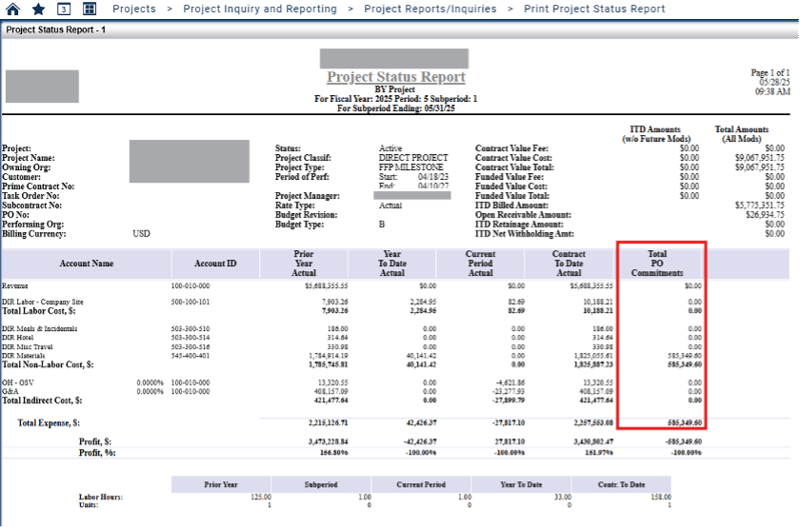
In this multi-part article series, we are highlighting some of the lesser-known Deltek Costpoint Procurement features that we regularly find manufacturing clients are not taking full advantage of. In many cases, they are features that users are not even aware exist. There is so much capability contained within Costpoint, and our goal at Redstone GCI is to help you unlock the full potential of the immensely powerful Deltek Costpoint tool that you are already paying for! In procurement, given how transactional & repetitive the tasks are, small changes to how you utilize Deltek Costpoint can multiply out to a large ROI and make life easier for your Procurement team, your stakeholders, and beyond.
Reflecting Purchasing Open Commitments on Project Status Reports (PSR’s)
When you execute a purchase order with a vendor, you have made a commitment to that vendor to spend a set amount of money in exchange for goods/services. While you haven’t yet expended the funds physically, for all intents and purposes, you should be planning your project as if that money is already spent. This commitment, in Costpoint, is referred to as an “Open Commitment.” The ability to capture purchasing “Open Commitments” in your project reporting is a major benefit of performing the purchasing function within Costpoint, instead of an external system. This moves the visibility of planned expenditures to the beginning of the procurement process, instead of project reporting only being aware of planned expenditures with a vendor once the PO has been completed and vouchered by AP.
Now, assuming the purchasing commitments are housed in Deltek Costpoint (which I strongly encourage), how can you put that data to use? One of the most common reports that F&A and Project Managers utilize to monitor project status is called the “Project Status Report” (PSR). This report offers flexibility in the columns that can be displayed, but generally, people have it structured with various categories of “Actual” expenses to the project. Imagine columns for “Current Period Actual” / “Year to Date Actual” / “Prior Year Actual” / etc., with the rows representing the various General Ledger Accounts that the costs have been posted to. The key is that the typical columns people have on their PSR are “ACTUAL” costs, which are costs that have been posted to the General Ledger. What is missing on many PSRs we see with clients is a column that reflects the “Total PO Commitments.” By adding this column, you can now see actual costs in the other columns, as noted, but then add a final column that also lists “Total PO Commitments,” painting the full picture of dollars allocated. So, if you have a $100K budget, but have $70K of actuals incurred and $20K of Open PO Commitments, you really only have a remaining budget of $10K. Without the PO Commitments being listed on this report, you’d be flying blind and believe you had $30K in budget remaining, which is incorrect. Such an easy change makes an already valuable report (the PSR) far more valuable, being a one-stop shop for data that allows you to manage and monitor your projects effectively.
Sample of a PSR with Total PO Commitments included

“Buy with Component” Parts and POs
Many businesses have a need for this function, but don’t realize there is a way to handle it in Costpoint properly. A “Buy with Component” part is a situation where you buy/receive into inventory component(s) from Vendor A on PO #1 and subsequently supply them to Vendor B as “Customer Furnished Material” (you are the customer) so that Vendor B can incorporate them into a product (which is the “Buy with Component” part number) that they are manufacturing for you on PO #2. You will then subsequently receive the “Buy with Component” part into inventory when you receive PO #2 from Vendor B. Please note that PO #2 is not for a service; it is for the “Buy with Component” assembly part number.
Why Do You Need This?
The components you bought from Vendor A exist in your inventory, and they have value/traceability. Suppose you were consuming them into a Manufacturing Order (MO). In that case, you’d issue them into that MO as the proper consumption method so that cost and traceability carry into the higher assembly, and the components are removed from inventory. Likewise, if you are supplying them to Vendor B to manufacture the part that you are outsourcing, it is no different; the components need to be consumed out of inventory for costing and traceability purposes, and therefore need to be issued into PO #2.
How Does Deltek Costpoint Meet Your Needs?
Costpoint has structured a PO Line to work similarly to an MO with regard to sub-components. PO Lines support having reservations to drive demand for lower-level components, which also supports proper MRP planning. They can also have pick lists printed and issue transactions performed against them. When you ship components to Vendor B, you would perform an “Issue to PO” transaction, which would satisfy the reservation line(s), consume the inventory, and carry forward the cost and traceability of the component(s) into the appropriate PO Line. Note that POs can have many components issued into them, if applicable.
Example: If I buy a $100 PART A from Vendor A and supply it to Vendor B, who I am paying $900 to manufacture PART B, I want to pay each vendor the respective money they are owed on their POs ($100 / $900 respectively), but in the end, I have a PART B in inventory that is truly worth $1,000. When you issue a PO, it sums the costs together for inventory purposes, similar to how an MO accumulates costs, and the resulting inventory is the sum of all input costs ($1,000 in this case).
Outsourcing Manufacturing Services from a Manufacturing Order
In the “Buy with Components” example above, we were outsourcing the complete manufacture of an entire assembly. Conversely, we may not outsource the full manufacture of an assembly, but instead, outsource step(s) in the manufacturing process due to the lack of particular manufacturing capability within our facility. Examples of this tend to be things like anodization, passivation, heat treat, unique testing, etc. Costpoint supports properly costing and tracking this as well, utilizing the procurement module in conjunction with the Production Control module (where MO’s are housed).
Many people do this improperly, in that they just write standalone service PO’s to have the outside services performed. The problem with this method is that the cost for those outside services does not get accumulated into the Manufacturing Order’s (MO’s) cost, since they are disassociated, and therefore the resultant inventory relieved of the MO is not fully valued to include the cost of the outsourced manufacturing services.
How Does Deltek Costpoint Meet Your Needs?
Costpoint has established functionality to support outsourcing specific manufacturing operations, ensuring accurate costing properly. The Production Control module (MO module) has an application called “Create MO Subcontract Requisitions” that will allow you to write ad hoc Purchase Requisitions (PRs) directly associated with a specific MO. Additionally, if you also utilize the Router Module, this application will inform you of the need for and automatically generate PRs for “Subcontractor Operations” from your MO’s router. This further increases the capability by adding streamlining features for repeatedly outsourced operations. That is a discussion for another day.
In either case, the resulting PR and subsequently generated PO will associate the cost of the outsourced service directly back to the MO, rolling it into the “Subcontract” bucket within the Finished Good inventory abbrev. This cost rolls up to place into inventory, upon MO relief, a fully costed assembly, which would include the material costs, the subcontracted (outsourced) costs, and any labor you charged internally while manufacturing the part.
How We Can Help
As you can see, there are many unique features that Costpoint’s Procurement module supports that will help to take your manufacturing business to the next level. The more you dig, the more you find! In our next and final article in this series, we will dive into additional procurement features for manufacturers, including:
- The “Replace” Function
- Costpoint Generated Request for Quotes (RFQs)
- Alternate Part Numbers
In the meantime, our experts at Redstone Government Consulting are here to support you. Please reach out if you’d like to discuss any of these topics, schedule an assessment of how you are currently utilizing Costpoint’s Procurement modules, or discuss implementation of these or other modules for your manufacturing business.


 Jesse Kepner is a Director and Subject Matter Expert within Redstone GCI’s Costpoint Consulting group, specializing in materials and manufacturing for government contractors. With more than two decades of experience spanning engineering, supply chain, and ERP system implementation, Jesse brings a uniquely comprehensive perspective to each engagement. He leverages extensive technical knowledge of Deltek Costpoint, formal engineering training, and a strong understanding of manufacturing operations, procurement, SCM, and financial systems to help clients design and implement scalable solutions that align business processes with system architecture, rather than forcing systems around outdated workflows. Jesse’s expertise makes him a trusted advisor to clients seeking digital transformation within highly regulated industries like aerospace and defense. Professional Experience Jesse’s career spans over 20 years, beginning as an RF Design Engineer supporting advanced antenna and radome development & manufacture in the defense industry. He advanced through roles in project engineering, procurement, and senior supply chain management at a major aerospace and defense prime contractor, where he was responsible for $40M+ in procurement spend and $70M+ in material and tooling inventory across multiple locations. During this time, Jesse navigated the complexities of implementing and utilizing Costpoint within both R&D and Production centric manufacturing environments, championing the successful implementation of Deltek Costpoint, MRP, and lean manufacturing processes at multiple locations across the corporation. Before joining Redstone GCI, Jesse served as Director of Costpoint Materials & Manufacturing with a Deltek Partner firm, where he led consulting engagements across the full project lifecycle, from initial discovery to implementation and post-go-live support. He built and led a team of manufacturing consultants and maintained close collaboration with Deltek’s product, marketing, and engineering teams. Jesse holds a Bachelor of Science in Electrical Engineering from the University of Dayton and an MBA with a concentration in Project Management from Wright State University. He is a Certified Supply Chain Professional (CSCP) through ASCM and a frequent presenter at Deltek’s ProjectCon Conference. Known throughout the Deltek community for his ability to solve complex challenges through practical, integrated solutions, Jesse brings a systems mindset and hands-on experience that directly benefit Redstone GCI’s Costpoint clients.
Jesse Kepner is a Director and Subject Matter Expert within Redstone GCI’s Costpoint Consulting group, specializing in materials and manufacturing for government contractors. With more than two decades of experience spanning engineering, supply chain, and ERP system implementation, Jesse brings a uniquely comprehensive perspective to each engagement. He leverages extensive technical knowledge of Deltek Costpoint, formal engineering training, and a strong understanding of manufacturing operations, procurement, SCM, and financial systems to help clients design and implement scalable solutions that align business processes with system architecture, rather than forcing systems around outdated workflows. Jesse’s expertise makes him a trusted advisor to clients seeking digital transformation within highly regulated industries like aerospace and defense. Professional Experience Jesse’s career spans over 20 years, beginning as an RF Design Engineer supporting advanced antenna and radome development & manufacture in the defense industry. He advanced through roles in project engineering, procurement, and senior supply chain management at a major aerospace and defense prime contractor, where he was responsible for $40M+ in procurement spend and $70M+ in material and tooling inventory across multiple locations. During this time, Jesse navigated the complexities of implementing and utilizing Costpoint within both R&D and Production centric manufacturing environments, championing the successful implementation of Deltek Costpoint, MRP, and lean manufacturing processes at multiple locations across the corporation. Before joining Redstone GCI, Jesse served as Director of Costpoint Materials & Manufacturing with a Deltek Partner firm, where he led consulting engagements across the full project lifecycle, from initial discovery to implementation and post-go-live support. He built and led a team of manufacturing consultants and maintained close collaboration with Deltek’s product, marketing, and engineering teams. Jesse holds a Bachelor of Science in Electrical Engineering from the University of Dayton and an MBA with a concentration in Project Management from Wright State University. He is a Certified Supply Chain Professional (CSCP) through ASCM and a frequent presenter at Deltek’s ProjectCon Conference. Known throughout the Deltek community for his ability to solve complex challenges through practical, integrated solutions, Jesse brings a systems mindset and hands-on experience that directly benefit Redstone GCI’s Costpoint clients.